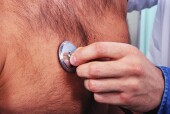
MONDAY, Dec. 20 (HealthDay News) — Leading U.S. cardiac experts have relaxed the recommendations for strict heart rate control in patients with atrial fibrillation, an irregular heart rhythm that can lead to strokes.
More lenient management of the condition is safe for many, according to an update of existing guidelines from the American College of Cardiology and the American Heart Association (AHA).
Atrial fibrillation, stemming from erratic beating of the heart’s two upper chambers, affects about 2.2 million Americans, according to the AHA. Because blood can clot while pooled in the chambers, atrial fibrillation patients have a higher risk of strokes and heart attacks.
“These new recommendations advance the many options we have available to treat the increasing number of people with atrial fibrillation,” said Dr. Ralph Sacco, AHA president and chairman of neurology at the University of Miami Miller School of Medicine.
“Health-care providers and patients need to be aware of the many more options we now have,” Sacco added.
Under the new recommendations, treatment will aim to keep a patient’s heart rate at rest to fewer than 110 beats per minute in those with stable function of the ventricles, the heart’s lower chambers. Prior guidelines stated that strict treatment was necessary to keep a patient’s heart rate at fewer than 80 beats per minute at rest and fewer than 110 beats per minute during a six-minute walk.
“It’s really been a long-standing belief that having a lower heart rate for atrial fibrillation patients was associated with less symptoms and with [better] long-term clinical outcomes and cardiac function,” said Dr. Gregg C. Fonarow, a professor of cardiology at the University of California Los Angeles. “But that was not subject to a prospective, randomized trial.”
Patients suffering from symptoms of rapid heart rate will still need treatment, and the long-term effects of persistent arrhythmias on the ventricles are still of concern, Dr. L. Samuel Wann, chair of the focused-update writing group, said in a news release from the heart organizations.
The updated recommendations are reported in the Dec. 20 online edition and the Jan. 4 print issue of the journal Circulation. They will also be published in the Journal of the American College of Cardiology and HeartRhythm. The purpose of the update is to get new findings incorporated into patient care as quickly as possible.
Fonarow noted that the new thinking could lead to patients taking fewer daily medications, more convenient treatment and perhaps the elimination of significant side effects from some of the drugs.
“For patients on six to nine medications, that’s a big difference,” he said. “They can get comparable quality of life with less meds. The focus can be to make sure they’re protected adequately from the risk of stroke.”
Other treatment changes in the updated guidelines include:
- Prescribing a combination of aspirin and the clot-preventing drug Plavix (clopidogrel) for patients who are poor candidates for Coumadin (warfarin), a powerful clot-preventing drug that requires regular testing to assess its effectiveness and correct dosage.
- Prescribing dronedarone, a pill that controls heart rhythm, in place of amiodarone, another anti-arrhythmic, to reduce side effects and hospitalizations.
- Supporting the greater use of catheter ablation, a procedure that utilizes radiofrequency energy to destroy small areas of tissue in the heart responsible for irregular heartbeat.
Fonarow said he was disappointed the revised guidelines could not recommend the use of the new anti-clotting drug dabigatran, which was approved by the U.S. Food and Drug Administration in October.
“Because of the timing, it’s not addressed in this report,” Fonarow said. “I certainly look forward to seeing it in the official guidelines.”
More information
To learn more about atrial fibrillation, visit the U.S. National Library of Medicine.

